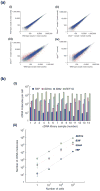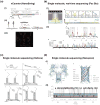Single cell analysis: the new frontier in 'omics'
- PMID: 20434785
- PMCID: PMC2876223
- DOI: 10.1016/j.tibtech.2010.03.002
Single cell analysis: the new frontier in 'omics'
Abstract
Cellular heterogeneity that arises from stochastic expression of genes, proteins and metabolites is a fundamental principle of cell biology, but single cell analysis has been beyond the capability of 'omics' technology. This is rapidly changing with the recent examples of single cell genomics, transcriptomics, proteomics and metabolomics. The rate of change is expected to accelerate owing to emerging technologies that range from micro/nanofluidics to microfabricated interfaces for mass spectrometry to third- and fourth-generation automated DNA sequencers. As described in this review, single cell analysis is the new frontier in omics, and single cell omics has the potential to transform systems biology through new discoveries derived from cellular heterogeneity.
Figures





References
-
- Irish JM, et al. Mapping normal and cancer cell signalling networks: towards single-cell proteomics. Nat Rev Cancer. 2006;6:146–155. - PubMed
-
- Graf T, Stadtfeld M. Heterogeneity of embryonic and adult stem cells. Cell Stem Cell. 2008;3:480–483. - PubMed
-
- Cai L, et al. Stochastic protein expression in individual cells at the single molecule level. Nature. 2006;440:358–362. - PubMed
-
- Rosenfeld N, et al. Gene regulation at the single-cell level. Science. 2005;307:1962–1965. - PubMed
-
- Weinberger LS, et al. Stochastic gene expression in a lentiviral positive-feedback loop: HIV-1 Tat fluctuations drive phenotypic diversity. Cell. 2005;122:169–182. - PubMed
Publication types
MeSH terms
Grants and funding
LinkOut - more resources
Full Text Sources
Other Literature Sources
Research Materials

